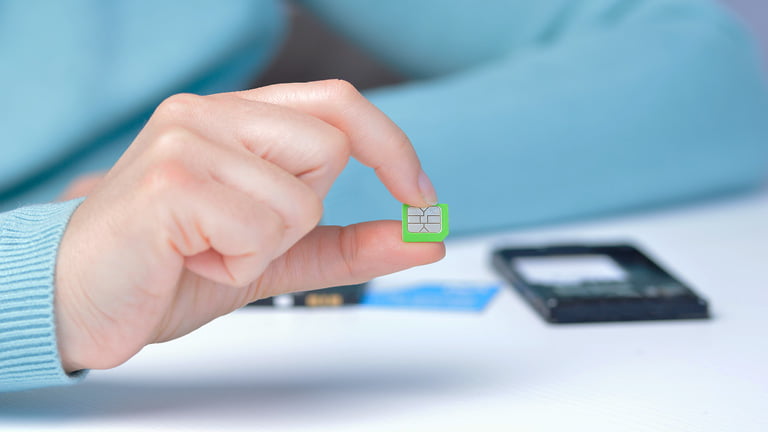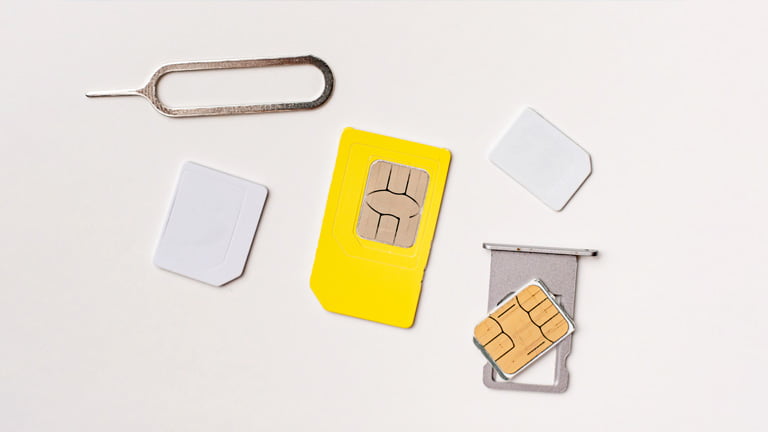
The SIM cards in our phones have been going through changes over the years. One of the recent changes is the introduction of virtual SIM cards, also known as eSIM. In the last couple of years, virtual SIM cards have become a popular alternative to physical SIM cards, especially for travelers and those who use multiple devices.
Most recently released mobile devices, including smartphones, smartwatches, and tablets, support eSIM. But what is a virtual SIM card, and how does it work? That’s the question we are going to address in this guide. We will also discuss everything you need to know about virtual SIM cards, including how they work, their benefits, limitations, and more.
Evolution of the SIM card
SIM cards have come a long way since their inception in the early 1990s. For those who may not know, the very first SIM cards were the size of a credit card since they were designed to fit into the first version of mobile phones, which were large and bulky.
As phones were getting smaller and more sophisticated, there was a need to change the size of the SIM cards to optimize for space. Here are the generations SIM cards have gone through;
- Full-size SIM card
The first SIM card was the size of a credit card and measured 85.6mm x 53.98mm x 0.76mm. - Mini-SIM card
The mini-SIM was created in 1996 and measured 25mm x 15mm x 0.76mm. This smaller size was ideal for more compact mobile phones released then. - Micro-SIM card
This was introduced in 2003, with dimensions of 15mm x 12mm x 0.76mm. The goal of the Micro-SIM card was to create more space for additional components in phones and other mobile devices. - Nano-SIM card
In 2012, the nano-SIM card was introduced, measuring just 12.3mm x 8.8mm x 0.67mm. Most modern devices still use nano-sim. - Virtual-SIM (eSIM) card
The eSIM standard was introduced in 2016. Most devices adopted it after 2017. With eSIM, the SIM card hardware is built into the device—more about this in the next section.
What is a virtual SIM card (eSIM)?
A Virtual SIM card is an embedded SIM card that allows users to access mobile networks without inserting a physical SIM card into their device. With virtual SIM cards, you don’t need to swap the SIM card from one device to another when switching devices. The process of setting it up is entirely software-based. People often refer to eSIM as Virtual SIM cards because people don’t get to see actual physical SIM card plates for eSIM.
Instead of being tied to a specific device, virtual SIM cards can be accessed from any device with an internet connection. This makes them a convenient option for those who frequently switch between devices or travel internationally. The Google Pixel 2 was the first smartphone built with eSIM. Most of the flagship smartphones released after the Pixel 2 support eSIM.
In a controversial move, Apple decided to ditch the physical SIM card slot on their recently released iPhone 14 series for US customers. All iPhone 14 models in the US only allow eSIM since they don’t have a slot for the physical SIM card. This is a clear sign that virtual SIM cards are the future, thanks to their many benefits over physical ones.
How does virtual SIM card work?
In terms of functionality, virtual SIM cards work just like traditional SIM cards. The main difference is that with eSIMs, the SIM hardware is built right into the device, so there is no need to insert a physical card for the device to access mobile networks. As mentioned earlier, virtual SIM cards are not tied to a specific device, so the process of setting them is entirely software-based.
To set up a cellular plan with a virtual SIM card, you must first purchase an eSIM plan. For instance, if you want to use eSIM for a secondary cellular plan while traveling abroad, you can purchase an eSIM plan from the best online providers like eSIM USA and eSIM Europe. You can receive the eSIM plan as a QR code and activation code after the order has been made successfully. After installing a prepaid eSIM plan, you can access the internet via a local provider.
Once the virtual SIM card is activated, you can use mobile data on your device just like you would with a physical SIM card. As you might have noticed, setting up your virtual SIM card requires your device to have access to the internet (WiFi or cellular) to connect to the virtual SIM card service since you have first to download the eSIM profile.
Modern devices also allow you to set up multiple eSIM cards by dual SIM feature with physical SIM and eSIMs on one device. Although some devices will allow you to have only two active SIMs, some of the latest devices like the new iPhones, you can set up eight or more eSIMs. This will enable you to switch between the different SIMs without repeating the lengthy setup process.

Benefits of virtual SIM cards
1. Convenient and flexible
With virtual SIM cards, you can switch between devices without taking out and inserting a physical SIM card. This means you can switch SIM cards digitally with just a few clicks, making it ideal for travelers and people who need to be connected to different local network providers frequently.
2. Cost-effective
If your device supports a virtual SIM card, you can switch carriers without purchasing a physical SIM card. This is particularly useful for those who frequently travel to different countries, as it eliminates the need to pay for costly international roaming charges or to purchase a new physical SIM card when visiting a new country.
Besides the cost savings associated with not needing to purchase a physical SIM card, eSIMs can also make it more convenient to use multiple cellular profiles with different eSIM cards. This is because eSIMs are stored electronically, so you can have various eSIM profiles on a single device, allowing you to switch between them whenever needed. For example, you could have a personal eSIM profile and a traveler eSIM profile and easily switch between them depending on which one you need to use at any given time.
3. Easy to use
As mentioned earlier, setting up a virtual SIM card is straightforward, as it only requires a few clicks. This makes them a convenient option for those who are not tech-savvy or prefer a simple setup process. After setting up your eSIMs, you can switch between them without going through the setup process again.
4. Secure
Unlike physical SIM cards that can be lost or stolen, eSIMs are stored electronically and usually protected by a unique encryption key to secure the SIM profile. Encryption provides an extra layer of security to prevent unauthorized access to the SIM card’s information, such as your data, contacts, and call records.
In addition to encryption, eSIMs also offer other security features, such as remote wipe and lock capabilities. So, if your mobile device is lost or stolen, you can remotely wipe the eSIM data to prevent unauthorized access. This feature is particularly useful for those who store sensitive information on their devices or use their phones for business purposes.
5. Not prone to damage
Since virtual SIM cards are stored electronically, they are not vulnerable to physical damage like physical SIM cards. Physical SIM cards can be damaged or scratched, resulting in data loss or failure to authenticate with the network. eSIMs, on the other hand, are more reliable and less prone to failure, which is especially important for those who rely on their devices to do essential tasks.
6. Environmentally friendly
Traditional SIM cards are typically made of plastic, and the production and disposal of these cards can significantly impact the environment. On the other hand, virtual SIM cards do not require a physical card, so they significantly reduce the amount of plastic waste generated.
This is because eSIMs are stored electronically, eliminating the need for physical materials. As a result, virtual SIM cards are a more sustainable and eco-friendly option, especially for those who use multiple devices and need to replace their SIM cards frequently. Furthermore, eSIMs also reduce the carbon footprint associated with the transportation of physical SIM cards.
Physical SIM cards need to be shipped to retailers, distributors, and customers, and this transportation generates greenhouse gas emissions. With virtual SIM cards, there is no need for shipping physical cards, so the carbon footprint associated with transportation is significantly reduced.
7. Easier to switch network carrier
With eSIMs, you can switch carriers without physically swapping out SIM cards. If you want to try to be connected with another network, you can simply change network carrier on your phone settings, and your device will automatically switch to the new carrier. This process is usually quick and easy, and you can switch back to your previous network carrier just as easily if you want to.
So, if you are frustrated with the connection of your current network carrier, eSIMs make it easier to switch to the next one. In the long run, the ease of switching carriers will increase competition in the industry, leading to much better services from the carriers.
Limitations of virtual SIM cards
Despite the many benefits, virtual SIM cards have a couple of limitations that all responsible stakeholders must consider to improve the users’ experience. Some of these include;
1. Limited carrier support
In some regions like Asia and Africa, only a handful of carriers support eSIM.
2. Limited device compatibility
Not all devices are compatible with virtual SIM cards, so you must ensure your device supports eSIMs before purchasing one. It is worth knowing that most devices released before 2017 don’t support eSIM.
3. Possible technical issues
eSIMs are a relatively new technology, and there may be some technical issues or glitches that can cause problems, especially when setting it up.
4. Require internet to set up
eSIMs require an internet connection (WiFi or cellular) to set them up. Only iPhone 14 series from the USA is allowed to be set up without internet. This can be an issue if you travel or use your device in areas without internet access.

FAQ about Virtual SIM cards
These are some of the common questions people ask about eSIMs.
Can my phone use a virtual SIM card?
Most of the recently released phones support virtual SIM cards (eSIMs). However, there are various ways to determine whether your phone supports eSIM. Here is how you can check.
· Check phone specs
First, you can check the device specs on your manufacturer’s website to determine if it has eSIM support.
· Check your phone’s settings
Go to your phone’s Settings and look for a section on SIM or cellular settings. If your phone has virtual SIM card support, there should be an option to add a cellular plan or add an eSIM.
How do I turn a normal SIM into a virtual SIM?
Turning a normal SIM card into a virtual one is not possible. This is because a virtual SIM card is embedded into the device’s hardware and cannot be physically removed or transferred to another device. However, your current phone number can be added to a virtual SIM by your domestic carrier if your device supports eSIM technology.
Can virtual SIM cards be damaged?
No, since virtual SIM cards are embedded into the device’s hardware, they are not prone to physical damage. However, virtual SIMs can be subject to technical issues, especially if there is a problem with the device’s hardware or software.
How much does it cost to use eSIM?
Most of the time eSIMs are free to activate since the hardware is already built into your device. You only need to purchase a plan from a carrier that supports eSIM technology.
Can I use eSIMs on multiple devices?
No, you can’t use the same eSIM on multiple devices even if the devices support eSIM technology. Once you install a plan in the device, you must use hotspot to share data with other devices or transfer eSIM to the other device, since it can’t be used simultaneously on multiple devices.
Final thoughts
In summary, a virtual SIM card known as eSIM is a superior alternative to the traditional physical SIM cards we have used for several years. With a virtual SIM card, you can activate a mobile network connection without needing a physical SIM card, which offers convenience, flexibility, and cost savings.
Additionally, you can switch between different network providers and plans easily without swapping physical cards. The good news is that all popular smartphones and mobile carriers in the USA now support virtual SIM cards. To enjoy the many benefits of eSIMs, consider getting a phone that supports this technology. Furthermore, eSIM USA offers excellent and affordable traveler eSIM plans you should consider checking out when traveling to the USA.



